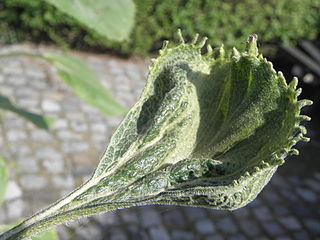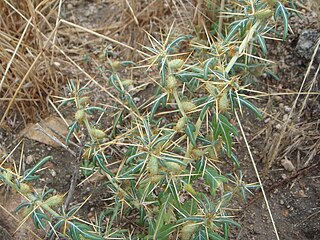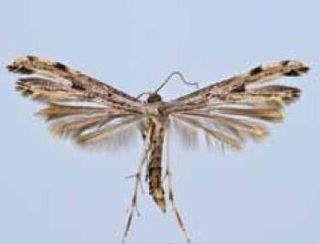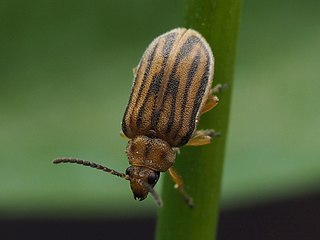
Xanthium (cocklebur) is a genus of flowering plants in the tribe Heliantheae within the family Asteraceae, native to the Americas and eastern Asia and some parts of south Asia.

The Heliantheae are the third-largest tribe in the sunflower family (Asteraceae). With some 190 genera and nearly 2500 recognized species, only the tribes Senecioneae and Astereae are larger. The name is derived from the genus Helianthus, which is Greek for sun flower. Most genera and species are found in North America and South America. A few genera are pantropical.

Ambrosia artemisiifolia, with the common names common ragweed, annual ragweed, and low ragweed, is a species of the genus Ambrosia native to regions of the Americas.

Parthenium is a genus of North American annuals, biennials, perennials, subshrubs, and shrubs in the tribe Heliantheae within the family Asteraceae and subfamily Asteroideae.

Plasmopara halstedii is a plant pathogen infecting sunflowers. The species is one of many pathogens commonly referred to as downy mildew. P. halstedii originated in North America.

Epiblema otiosana, the bidens borer moth, gets its common name from the genus Bidens which includes the food plants for the larva. An adults wingspan ranges from 12 to 20 millimetres. They range in North America from Maine and Ontario in the north, south to Florida and west to Kansas and Texas.

Chlosyne lacinia, the bordered patch or sunflower patch, is a North and South American butterfly in the family Nymphalidae.

Euaresta is a genus of flies in the family Tephritidae that live in plants of the closely related genera Ambrosia, Xanthium, and Dicoria, and feed on their flowers and seeds.

Hellinsia lienigianus is a moth of the family Pterophoridae which inhabits coastal areas, dry pastures and waste ground and is found in Africa, Asia, Australia and Europe. Also known as the mugwort plume it was first described by Philipp Christoph Zeller in 1852.
Bucculatrix parthenica is a moth of the family Bucculatricidae. It is native to Mexico, but was released in Queensland, Australia, as a biological control agent for Parthenium weeds. It was described by John David Bradley in 1990.

Parthenium hysterophorus is a species of flowering plant in the family Asteraceae. It is native to the American tropics. Common names include Santa-Maria, Santa Maria feverfew, whitetop weed, and famine weed. In India, it is locally known as carrot grass, congress grass or gajar ghas or dhanura. It is a common invasive species in India, Australia, and parts of Africa.

Xanthium spinosum is a species of flowering plant in the aster family known by many common names, including spiny cocklebur, prickly burweed and Bathurst burr. This species is part of the genus Xanthium that encompasses 25 different species of flowering plants of the daisy family, Asteraceae, and sunflower tribe.

Adaina ambrosiae is a moth of the family Pterophoridae. It is found in North America from California east to Florida and north to Ontario. It is also known from Bermuda, Costa Rica, Jamaica, Puerto Rico and the Virgin Islands.

Hellinsia inquinatus is a moth of the family Pterophoridae. It is found in North America, including Florida, Mississippi, Oklahoma, Tennessee, Maryland, Alabama, Texas, Missouri, Colorado and Arizona. It has also been recorded from Hispaniola, Mexico, Puerto Rico and St. Thomas Island.
Bucculatrix ambrosiaefoliella is a species of moth in the family Bucculatricidae. It is found in North America, where it has been recorded from California, Texas, Arizona, Pennsylvania, Kentucky, Missouri, Iowa, Maine and Ohio. The species was first described by Vactor Tousey Chambers in 1875.

Ophraella communa, common name ragweed leaf beetle, is a species of beetles belonging to the family Chrysomelidae.
Ostrinia obumbratalis, the smartweed borer, is a moth in the family Crambidae. It was described by Julius Lederer in 1863. It is found in North America, where it has been recorded from New Brunswick and Manitoba to Louisiana and Florida.

Ponometia candefacta, the olive-shaded bird-dropping moth, is a moth of the family Noctuidae. It is found in North America, where it has been recorded from the northern United States to southern Mexico. It has been introduced to Russia as a biological control agent of Ambrosia artemisiifolia. The habitat consists of dry, weedy, disturbed areas at low elevations.
Xanthium ambrosioides, the Argentine cocklebur, is a species of flowering plant in the family Asteraceae, native to Argentina, and introduced to Great Britain, France, Italy, and New South Wales. Some authorities consider it a synonym of Xanthium spinosum. It is a "Declared Pest, Prohibited" in Western Australia.

Ambrosiinae is a subtribe of flowering plants in the tribe Heliantheae, and is endemic to the Americas.
















